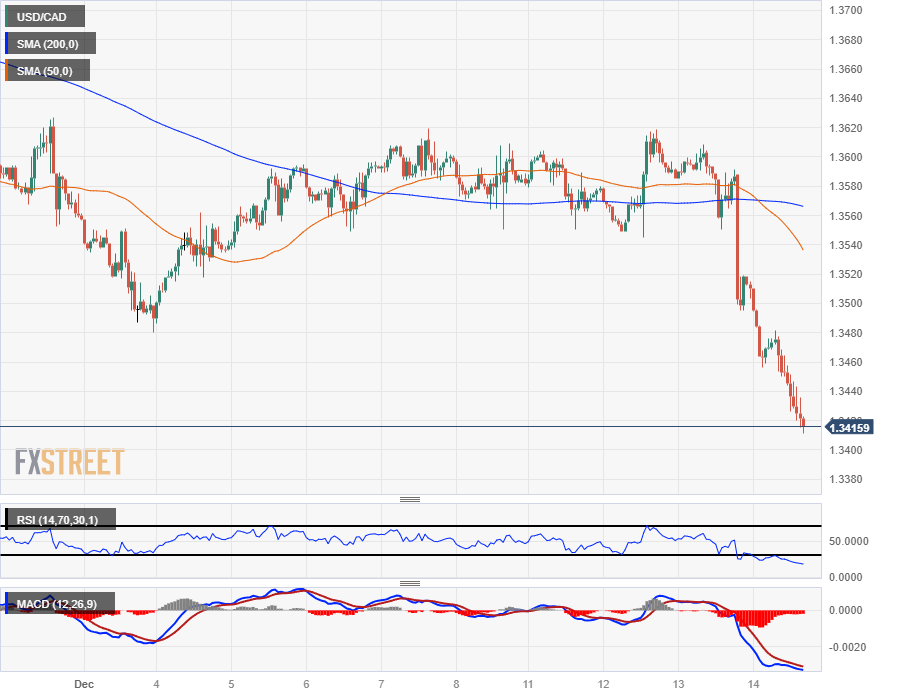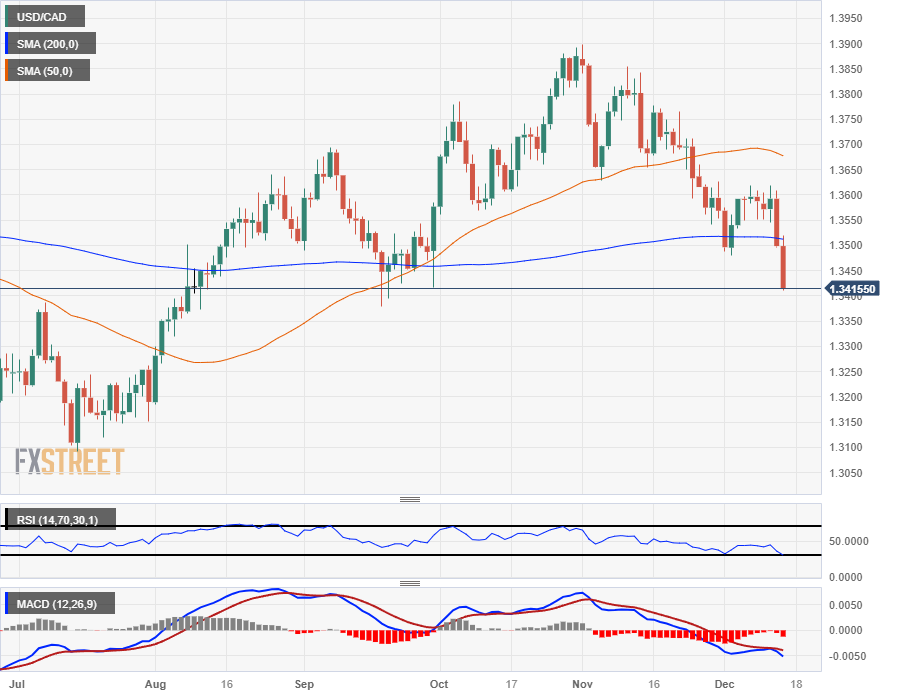- Analytics
- News and Tools
- Market News
- Canadian Dollar extends gains as WTI Crude Oil rebounds
Canadian Dollar extends gains as WTI Crude Oil rebounds
- Canadian Dollar gains further ground against the US Dollar in risk-on markets.
- Bank of Canada Governor Macklem slated to make an appearance on Friday.
- WTI Crude Oil ticks up to $72, lifts CAD higher.
The Canadian Dollar (CAD) is extending into a second straight day of gains against the US Dollar (USD) on Thursday as global markets see a broad improvement in risk appetite. The US Federal Reserve (Fed) pivoted on Wednesday, putting rate cuts on the table for the first time in years, sending market sentiment soaring and the USD plunging to fresh lows. The US Dollar was the single worst-performing currency of the majors on Thursday, bolstering the CAD to eleven-week highs.
Economic data from Canada remains strictly limited to low-tier datasets on Thursday, and CAD traders will be looking out for Bank of Canada (BoC) Governor Tiff Macklem’s speech late Friday. BoC Governor Macklem will be giving a speech at the Canadian Club of Toronto, and the pre-written speech notes will be released at 17:25 GMT. Audience questions are expected at the event.
Daily Digest Market Movers: Canadian Dollar propped up by a slow bleed in US Dollar flows
- The CAD is benefiting from structural flows on multiple fronts.
- A Fed-sponsored, broad-market USD sell-off is seeing a lift in nearly all risk assets.
- The Fed granted investors their wish on Wednesday, chalking in multiple rate cuts in 2024, and expects a 75 basis point decrease in the Fed rate by the end of next year.
- Markets are ignoring multiple data points to bid the week’s Fed action.
- US MoM Retail Sales for November printed well above expectations, showing a 0.3% increase versus the expected -0.1%, while October’s print saw a slight downside revision from -0.1% to -0.2%.
- Canadian Manufacturing Sales for October contracted steeper than expected, declining by 2.8% versus the forecasted 2.7% contraction, accelerating declines from September’s print of 0.7%, which also saw an upside revision from 0.4%, slightly steepening October’s decline.
- Crude Oil markets are on the mend with West Texas Intermediate (WTI) US Crude Oil climbing back to $72 per barrel.
- Crude Oil is catching a much-needed bid from Fed-inspired risk appetite, as well as declining barrel counts and a hopeful outlook from the Organization of the Petroleum Exporting Countries (OPEC).
Canadian Dollar price today
The table below shows the percentage change of Canadian Dollar (CAD) against listed major currencies today. Canadian Dollar was the strongest against the US Dollar.
| USD | EUR | GBP | CAD | AUD | JPY | NZD | CHF | |
| USD | -1.04% | -1.14% | -0.72% | -0.62% | -0.86% | -0.43% | -0.72% | |
| EUR | 1.03% | -0.09% | 0.33% | 0.40% | 0.17% | 0.59% | 0.31% | |
| GBP | 1.13% | 0.10% | 0.43% | 0.50% | 0.25% | 0.68% | 0.41% | |
| CAD | 0.71% | -0.33% | -0.43% | 0.07% | -0.16% | 0.26% | -0.01% | |
| AUD | 0.64% | -0.41% | -0.51% | -0.07% | -0.23% | 0.17% | -0.09% | |
| JPY | 0.87% | -0.14% | -0.23% | 0.17% | 0.27% | 0.45% | 0.16% | |
| NZD | 0.46% | -0.61% | -0.70% | -0.27% | -0.20% | -0.42% | -0.29% | |
| CHF | 0.73% | -0.31% | -0.41% | 0.02% | 0.09% | -0.15% | 0.27% |
The heat map shows percentage changes of major currencies against each other. The base currency is picked from the left column, while the quote currency is picked from the top row. For example, if you pick the Euro from the left column and move along the horizontal line to the Japanese Yen, the percentage change displayed in the box will represent EUR (base)/JPY (quote).
Technical Analysis: Canadian Dollar topside snap sends USD/CAD toward 1.3400
The Canadian Dollar (CAD) is seeing a firm recovery against the US Dollar (USD) extend into a second straight day, sending the USD/CAD further across the 200-day Simple Moving Average (SMA) near 1.3500 as the pair comes within reach of the 1.3400 handle on Thursday. At the time of writing, the Canadian Dollar is up seven-tenths of a percent against the US Dollar.
USD/CAD’s clean break of the 200-day SMA on Wednesday is extending, and Loonie bidders will be looking to push as far as they can toward July’s swing lows near 1.3100, with the low for 2023 etched in at 1.3092.
Near-term bearish acceleration sees the USD/CAD peeling away from intraday moving averages, with the 200-hour SMA just above 1.3560 and the 50-hour SMA accelerating into the low end after a bearish cross of the longer moving average. This proves to be a technical ceiling for any potential pullbacks into the chart region between 1.3540 and the 1.3500 handle.
USD/CAD Hourly Chart

USD/CAD Daily Chart

Canadian Dollar FAQs
What key factors drive the Canadian Dollar?
The key factors driving the Canadian Dollar (CAD) are the level of interest rates set by the Bank of Canada (BoC), the price of Oil, Canada’s largest export, the health of its economy, inflation and the Trade Balance, which is the difference between the value of Canada’s exports versus its imports. Other factors include market sentiment – whether investors are taking on more risky assets (risk-on) or seeking safe-havens (risk-off) – with risk-on being CAD-positive. As its largest trading partner, the health of the US economy is also a key factor influencing the Canadian Dollar.
How do the decisions of the Bank of Canada impact the Canadian Dollar?
The Bank of Canada (BoC) has a significant influence on the Canadian Dollar by setting the level of interest rates that banks can lend to one another. This influences the level of interest rates for everyone. The main goal of the BoC is to maintain inflation at 1-3% by adjusting interest rates up or down. Relatively higher interest rates tend to be positive for the CAD. The Bank of Canada can also use quantitative easing and tightening to influence credit conditions, with the former CAD-negative and the latter CAD-positive.
How does the price of Oil impact the Canadian Dollar?
The price of Oil is a key factor impacting the value of the Canadian Dollar. Petroleum is Canada’s biggest export, so Oil price tends to have an immediate impact on the CAD value. Generally, if Oil price rises CAD also goes up, as aggregate demand for the currency increases. The opposite is the case if the price of Oil falls. Higher Oil prices also tend to result in a greater likelihood of a positive Trade Balance, which is also supportive of the CAD.
How does inflation data impact the value of the Canadian Dollar?
While inflation had always traditionally been thought of as a negative factor for a currency since it lowers the value of money, the opposite has actually been the case in modern times with the relaxation of cross-border capital controls. Higher inflation tends to lead central banks to put up interest rates which attracts more capital inflows from global investors seeking a lucrative place to keep their money. This increases demand for the local currency, which in Canada’s case is the Canadian Dollar.
How does economic data influence the value of the Canadian Dollar?
Macroeconomic data releases gauge the health of the economy and can have an impact on the Canadian Dollar. Indicators such as GDP, Manufacturing and Services PMIs, employment, and consumer sentiment surveys can all influence the direction of the CAD. A strong economy is good for the Canadian Dollar. Not only does it attract more foreign investment but it may encourage the Bank of Canada to put up interest rates, leading to a stronger currency. If economic data is weak, however, the CAD is likely to fall.
© 2000-2024. All rights reserved.
This site is managed by Teletrade D.J. LLC 2351 LLC 2022 (Euro House, Richmond Hill Road, Kingstown, VC0100, St. Vincent and the Grenadines).
The information on this website is for informational purposes only and does not constitute any investment advice.
The company does not serve or provide services to customers who are residents of the US, Canada, Iran, The Democratic People's Republic of Korea, Yemen and FATF blacklisted countries.
Making transactions on financial markets with marginal financial instruments opens up wide possibilities and allows investors who are willing to take risks to earn high profits, carrying a potentially high risk of losses at the same time. Therefore you should responsibly approach the issue of choosing the appropriate investment strategy, taking the available resources into account, before starting trading.
Use of the information: full or partial use of materials from this website must always be referenced to TeleTrade as the source of information. Use of the materials on the Internet must be accompanied by a hyperlink to teletrade.org. Automatic import of materials and information from this website is prohibited.
Please contact our PR department if you have any questions or need assistance at pr@teletrade.global.















